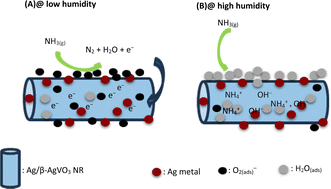Preparation and NH3 gas-sensing properties of Ag/β-AgVO3 nanorods
Abstract
NH3 gas sensors operating at room temperature, consisting of Ag nanoparticles decorated β-AgVO3 nanorods (Ag/β-AgVO3 NRs), were fabricated via a facile hydrothermal method without the need for a template. The surface characteristics and compositions of Ag/β-AgVO3 NRs were analyzed using X-ray diffraction (XRD), scanning electron microscopy (SEM) and transmission electron microscopy (TEM). Ag nanoparticles, ranging in diameter from approximately 20 to 40 nm, were dispersed on the surface of monoclinic β-AgVO3 NRs with diameters ranging from 50 to 105 nm and lengths from 0.3 to 1.3 μm. The NH3 gas sensing properties of Ag/β-AgVO3 NRs were studied under both dry air and humid conditions at room temperature. Comparative analysis demonstrated that the Ag/β-AgVO3 NRs exhibited a strong response to NH3 gas under 70% relative humidity (RH) at room temperature compared to α-AgVO3 NRs. Specifically, the response of the Ag/β-AgVO3 NRs to 5 ppm NH3 increased by 2.25 times as the RH varied from 20% to 80% at room temperature. This enhanced response was attributed to the effects of formation of nanoheterojunctions, nano-metallic Ag activity and the conductivity of NH4+ and OH− ions induced by the presence of humidity. The room temperature NH3 gas sensors based on Ag/β-AgVO3 NRs demonstrated strong responses to low NH3 concentrations, high selectivity, good reproducibility, and long-term stability, and show promise for the development of low-power and cost-effective NH3 gas sensors for practical applications even under high humidity.



 Please wait while we load your content...
Please wait while we load your content...